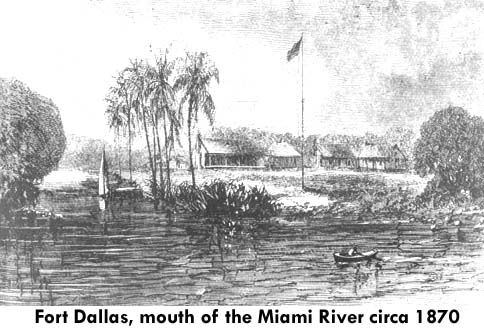|
Along
the By Jerry Wilkinson |
 |
|
Along
the By Jerry Wilkinson |
 |
|
The use of the
telegraph had existed in the world most of the 1800's. On May 24, 1844
Samuel Morse
sent the message, "What hath God wrought?" making telegraphy a part of
U. S. communication. In 1865 the Western Union Telegraph Co. was
established in Cleveland, OH. The following year (1857) the
Transatlantic cable began with many modifications following. The
telegraph was here to stay and it left its impact on Florida. One of the better and more comprehensive descriptions of the early Florida Keys was written by Dr. J. B. Holder for the Harper's New Monthly Magazine in 1871. Dr. Holder's first paper was published in March 1871 with another following each month until July. The articles cover his trips from Fort Dallas (Miami) to Fort Myers in 1860 and 1861. Let's allow Dr. Holder to introduce the subject as he did in the March 1871 issue on page 355 of Harper's New Monthly Magazine titled Along the Florida Reef. Note: While very interesting, but for sake of brevity, I omit his lengthy botanical observations using ellipses . . . . The series contain a total of 64 pages of small font with numerous etchings. The following is a small portion with selected etchings. Brackets [ ] contain my comments. JW "Purposing to aid the Cuban Telegraph Company, our government considered it advisable to make a reconnaissance of the great range of the keys upon the Florida Reef. "A cable from the mainland at Cape Sable to Key West has been laid; but at this time it was thought that the wires could be laid upon the trees and carried across the inlets upon poles set in the mud of the extensive flats between the islands. Several obstacles appeared after examination, the principal one being the interference with the passage of the numerous sponge-boats that find occupation here. The wild and rugged nature of the forest rendered it more difficult and expensive than the cable plan." [In 1858 the transatlantic submarine cable went operational. Cuba was linked to the US via a submarine cable to Key West, then to Punta Rassa near Fort Myers in 1866. Dr. Holder was in the Keys in 1860 and 1861. Fort Myers south was all Monroe County at that time.] "Major M'Farland, of the Engineers, was ordered to take charge of the survey, with the schooner Oriental, then in his employ. An examination of the Pine Keys had been made previously. Our destination was to Knight's Key, where we arrived after one night's sail, some sixty miles from Key West. . . . "Key Vaccas and Knight's Key lie parallel to each other. Here the water was so shallow that we were forced to leave our boats and push through the mud to deeper water. . . ." [This is exactly what the railroad found and they simply filled in instead of bridging. Today one can barely tell where Knight's Key, Hog Key and Key Vacca begin and end.]
"'Next day we visited Plantation Key. This is a very large island,
several
miles in length, and has a good beach. The mangroves are here replaced
by larger trees, and a variety of shrubs and small trees is supported
by
the deeper soil which has accumulated. A strong growth of course grass
and many flowering plants thrive well. "Tavernier Creek is another of the open waterways, quite like a river -- open runs produced by the tides. Here is the favorite haunt of the young sea-turtles, a good feeding -ground secure from the numerous enemies of the outer water. The green-turtle here finds in abundance the peculiar sea-weed which it prefers, and on which it thrives and fattens. During the breeding season they are easily taken while crawling upon the beaches to lay their eggs: but many are taking by pegging, as the turtler terms it. A prism shaped pointed steel peg is fitted to a socket in the end of a stout pole. A line holds the peg, and serves to draw the creature toward the boat after it has been driven into the shell and loosened from the pole.
"Fine specimens of the hawk's-bill turtle are caught here, having the
elegant
shells plates, or scales, so valued in jewelry and comb manufacturing.
The green turtle is most valued as an article of food, and the Key West
market is usually supplied from these back bays and creeks. The
loggerhead
turtle, a coarser and larger reptile, attaining a weight of several
hundred
pounds, feeds mostly off of flesh, and is caught upon the beaches
during
the breeding seasons. In the summer months, and on moonlight nights,
turtle
turning is practiced, and the visitor in these regions finds in it
exciting
recreation. "[Follows a lengthy description of turtling.]
"A large trade is now carried on at Key West in this article. Small schooners, from ten to twenty tons burden, are employed. They are much the shape of half an egg, and as flat as it is consistent with due regard to sailing qualities; approaching, probably, as near as possible the mystic craft that is said to 'float in a heavy dew'. . . . That portion of Key West called Conchtown is the principal depository, where the yards and fences are loaded with them. . . . "In the morning the yawl was refitted for another day on shore. We were anchored off Old Rhodes Key, and now stood off toward Plantation Key, and took out boats as soon as the water became too shoal to admit the schooner father in. Every where along the beach were fragments of wrecks. Old hulks are seen on the shores, and at high-water mark windrows of wood lined the shore. Here was a Turkish maiden, the figure-head of some unlucky ship, lying half buried with splinters and fragments of guilded panels, the remains of a wrecked steamship. Farther on a handsome sign-board bearing the Yankee name of Joseph A. Davis in guilt letters. Figureheads in scrollwork, handsomely carved. On another key, great numbers of new hogsheads and bundles of staves and barrels; part of a cargo, no doubt, destined for the 'ever-faithful isle.' "Plantation
Key has considerable good
soil;
many of the trees here are seventy or eighty feet in height. Here was a
large plantation of cocoa-nut palms, several hundred in number, and a
patch
of young pineapples. A late paper gives the account of the products of
his patch, which have been materially increased since the writer was
there.
Mr. Baker, the owner, who resides at Key West, is reported to have
realized
seven thousand dollars this season [1871] from his crop of pine-apples.
The great drawback is the prevalence of mosquitoes, throughout the
whole
year, in such swarms that few persons are willing to suffer the
annoyance;
otherwise these keys would richly reward the cultivator. Go to Page 2, or |
